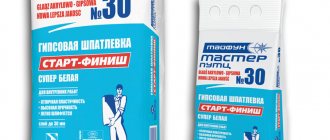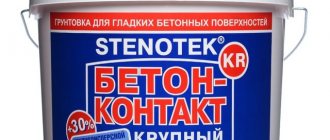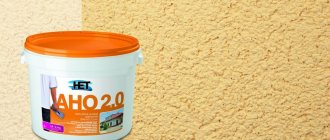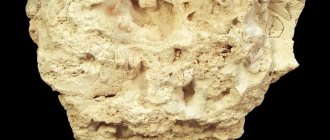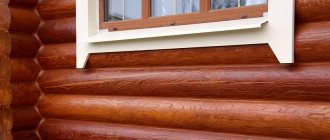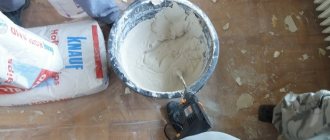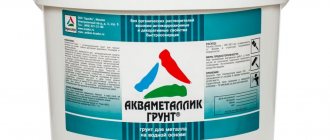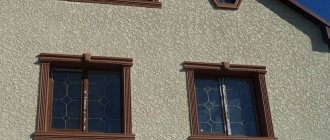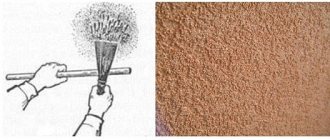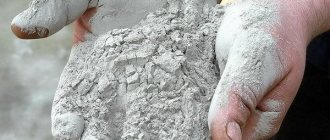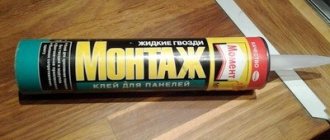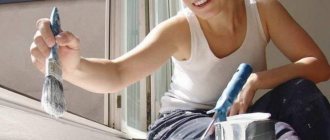05/10/2018 Gypsum plaster is a common finishing material used for repairs and furnishing of rooms with normal humidity. Today the construction market offers a wide range of such products. This allows you to select the appropriate option based on the requirements: place of application (ceiling, walls, inside, outside), application technology, consumption, type of subsequent finishing, color, packaging, technical characteristics, price, etc. Before purchasing, we recommend that you find out what differences between gypsum plasters should be taken into account, how to choose the material correctly and according to what parameters.
Soundproofing properties of cement and gypsum plasters
The ability of materials to absorb noise is of interest to many users. They would like to finish it and get not only a smooth wall, but also effective protection from “loud” neighbors. If you use standard gypsum or cement mortars , they will not provide good sound insulation.
True, the first option has slightly better insulating characteristics compared to the second. The best choice in this case is special soundproofing materials.
They are made on the basis of cement or gypsum. They contain a special filler, which gives the finish some looseness and porosity. This allows it to absorb sound well. The compound layer can be covered with drywall or the final finish can be applied directly to it. If the installation technology is followed, such mixtures are very effective.
Required Tools
To dilute the mixture, you will need a plastic container with a volume of at least 60-90 liters. For water, it is recommended to purchase buckets with marking scales. It is better to mix it with a construction mixer or a powerful drill with a special attachment. You can mix the solution by hand, but this is very labor-intensive. You need to make sure that no air bubbles or lumps form.
To apply gypsum plaster you will need:
- a rectangular trowel, spatula or trowel for applying mortar to the walls;
- h-shaped rule - for leveling the plaster layer (about 2 m);
- trapezoidal rule or wide spatula - for trimming;
- sponge grater - for puttying;
- iron spatula - for glossing;
- metal scissors, level, dowel, plumb line, tape measure, scraper - for preparatory work, installation of beacons and installation of the mesh;
- plaster beacons.
If you plan to work on the ceiling, then you need a plaster falcon. Nets and beacons are not installed on the ceiling. The reinforcing mesh itself must be made of galvanized metal or plastic so that it does not corrode.
General information
Preliminary leveling of horizontal and vertical surfaces of ceilings and walls is the main purpose of gypsum plaster. It is used to finish work surfaces in the final decorative finish.
Important,
that it can be applied in a thick layer and thanks to this it successfully copes with all irregularities and defects.
Gypsum-based plaster can mask obvious wall defects, including holes and serious damage. Gypsum plaster is used to treat ceilings and walls with high quality, which allows for further cladding, painting of walls or wallpapering.
Applying the solution in case of strong changes
Differences exceeding 5 cm require applying the solution in several layers, separated from each other by a reinforcing mesh. It facilitates the adhesion of the solution to the surface, gives it additional strength, and prevents shrinkage and cracking. Beacons are not always used in this case.
You will need to make notches on the first layer of plaster and apply the second layer only after the first has dried.
When plastering monolithic walls, they need to be sprayed a little to increase the degree of adhesion.
How to dry?
The surface should dry under natural conditions. There should be no drafts or operating heating devices in the room; the required air temperature should not be lower than +5 and not higher than +25°C. Direct sunlight on the coating is not allowed. Do not speed up drying with a heat gun or any other heating equipment.
After 3-7 days, the room must be thoroughly ventilated to remove moisture from the plaster layer. The plaster will dry completely and gain strength only after 1-2 weeks. The finished surface should be smooth and light. Then you can glue tiles or wallpaper onto it. And the moisture content of the coating for painting should not exceed 1%.
Which plaster to choose: cement or gypsum?
FORMAN GYPSUM PLASTER
In a number of characteristics, these materials are similar to each other, so it is necessary to consider those qualities and properties that differ from each other.
These include:
- price - gypsum plasters are about 1.5 times more expensive than cement plasters, but gypsum material is consumed 45% less. In addition, if the gypsum is applied with high quality, the surface will not need to be puttied, and the cement coating always needs to be treated. As a result, gypsum plaster will cost less than a cement mixture, especially if a large surface is being processed;
- adhesion and drying time - cement has a faster hardening rate, so gypsum mortar is applied within 45 minutes, and cement mortar can be applied within 2 hours. The gypsum mixture is formed several times in small portions, otherwise it will quickly become unsuitable for further use;
- scope of use of mixtures - cement plaster is more versatile, since it can be used for internal and external facade work. The gypsum composition cannot be used outdoors - it has lower performance qualities because it is deformed from excess moisture. By the way, this is why gypsum is not recommended for treating the walls of rooms with high humidity levels. Even the use of high-quality waterproofing will not improve the situation.
Kinds
Manufacturers mainly divide the types of gypsum plaster compositions according to two parameters.
Depending on the location of the surface being treated:
- For interior work, cheap universal plaster mixtures are used.
- For exterior work and surfaces in rooms with high humidity, more expensive facade mixtures or moisture-resistant gypsum plaster are used.
Taking into account further processing of the finished area:
- Starting - is done to level the walls and then apply a decorative coating to them.
- Finishing – simultaneously performs the function of a leveler and a decorative layer.
When choosing plaster, you should carefully read the manufacturer's instructions. It usually indicates for which surfaces the use of this mixture is recommended, and which application method is best to use - manual or machine. Mechanized processing creates a more durable and even layer, but the work requires special, expensive equipment. If the plaster is waterproof, this will be indicated on the packaging.
Polymer and mineral fillers make the structure of the solution light and elastic, so almost all gypsum plasters are suitable for surfaces made of a wide variety of materials. They are designed for leveling ceilings, as well as wooden, clay and concrete walls. Perlite plaster based on gypsum will help to significantly reduce material consumption, improve its strength and thermal insulation properties. Gypsum cement plaster creates a durable layer of finished surface that will be thinner than conventional cement plaster and will dry much faster.
The largest selection of gypsum plasters is presented in the form of dry mixtures. But if you are not sure that you will be able to prepare a solution of the required consistency yourself, you can purchase a ready-made paste. To get started using this solution, you just need to open the container. This material is more expensive than dry mixtures and is only suitable for manual application. It cannot be diluted with water or plasticizers, otherwise it will lose its properties.
Important nuances
Gypsum plaster is suitable for many surfaces. It can be applied to cement and lime plaster, drywall, wood and paint. It is also allowed to use gypsum mixtures on gas silicate blocks, logs, chipboard and expanded clay concrete. Such surfaces always need to be primed. For most of these materials, a regular universal primer of two or three coats will do, but for concrete floor slabs and paint it would be better to apply concrete contact.
Before you begin applying gypsum plaster, you need to carefully prepare the surface. All old decorative coatings are completely removed, grease stains, glue and dust are removed. If the wall or ceiling was previously painted, it is recommended to remove the paint layer completely. To do this, you can use a scraper or grinder with a grinding attachment. Loose layers of old plaster also need to be removed.
It is necessary to remove all metal elements from the surface being treated, since the gypsum layer increases the impact of corrosion on them. Metal parts that cannot be removed are generously coated with an anti-corrosion compound.
Large cracks, chips and other significant defects must be covered with cement mortar.
The minimum layer for some plaster mixtures is 5 mm. But the optimal thickness for a layer of plaster is within 1-2 cm. In cases where there are large defects on the surface, it may be necessary to increase the thickness of the coating to 8 cm. Under these circumstances, it will be necessary to reinforce the surface with galvanized or plastic mesh. Also, reinforcement of walls must be done in new buildings to prevent deformation during shrinkage of the building.
To install the reinforcing mesh on the entire surface of the wall, you need to apply markings every 35-45 cm with a marker. Holes are drilled along these marks using a hammer drill, and plastic rods from dowels are inserted into them. The mesh is cut into small rectangular pieces and overlapped with self-tapping screws. The distance from the wall to the reinforcing material should not be more than half the plaster layer
No deflections are allowed on the reinforcing frame , and vibration should not occur when touching it. To correct such defects, to strengthen the structure, a wire in the shape of the letter Z is threaded between the cells of the mesh. A plaster mixture of a thinner consistency is placed on the inside of the mesh. This layer is left for 10-20 minutes to dry and only after that a thicker outer layer is applied.
You may also need to install guide beacons. As such, you can use an aluminum profile for drywall, which must be removed after the plaster layer has dried. You can make your own beacons from a gypsum mixture. To do this, construct a vertical strip from the solution and level it using a level. You can work on gypsum beacons in 3-4 hours.
After the plaster has completely dried, it is necessary to check the uniformity of color and evenness of the surface. You can only check the color in the correct bright lighting. The finished coating must not have cracks or chips, and it should not be perfectly smooth or very porous. Only small pores are required on the surface. If there are any shortcomings, then a second thin layer of plaster should be applied on top of the finished coating.
When working with gypsum materials, you need to take into account many nuances. For example, you can add cement to gypsum, mix it with alabaster or sawdust. Various additives impart new properties and textures to the solution. You need to work very quickly with any gypsum solution. If it hardens, then it will no longer be possible to soak the frozen mixture for further work with it.
Peculiarities
Gypsum plaster is a modern finishing material that is used for applying both rough and finishing coatings. In general, gypsum-based mixtures are recommended for finishing interior spaces with low air humidity. But new technological additives and some additions to the process technology make it possible to use gypsum plasters in the bathroom, toilet or for exterior work.
Such modifiers are bulk fillers with different fraction sizes and polymer or mineral additives. They make the solution lighter and more flexible, and also improve its adhesion to various surfaces. The gypsum component regulates the microclimate of the room by absorbing moisture from cold air and then releasing it when the temperature in the room rises.
Gypsum plasters are suitable for correcting small and large surface defects, while they are easy to use
Gypsum plasters differ in their technical characteristics in many respects from cement and lime plaster mixtures. The features of these parameters mainly depend on the base component, which is a mineral of natural origin - gypsum. Differences between the properties of the solution and the finished coating are determined by the technological additives present in the mixture.
Regardless of the manufacturer and the characteristics of the ingredients, the finished gypsum coating has the following characteristics:
- Environmentally friendly. The surface of the material does not emit substances harmful to health even when heated and wet.
- Thermal insulation. The thermal conductivity of gypsum plaster at a density of 800 kg per m3 is in the range of 0.23-0.3 W/ (m°C).
- Noise insulation. Gypsum is a soft material and absorbs noise coming from outside.
- Vapor permeability. Natural ventilation and a comfortable microclimate in the room are achieved due to the absorption and release of moisture by the material, depending on the temperature and humidity of the air.
- Frost resistance. The frozen surface can withstand temperatures from -50 to +70°C.
- Hydrophilicity. Gypsum absorbs water very well. When excessively wet, the material acquires a dough structure.
During work, the air temperature must be maintained from +5 to +30°C. The room should be well ventilated, but drafts must be excluded. Direct sunlight on a wet layer of plaster can lead to cracks.
The material consumption for plastering 1 m2 of surface with a layer of 1 cm ranges from 8 to 10 kg. In one go, you can apply a layer of mortar up to 5-6 cm without reinforcement; with the installation of a reinforcing mesh, up to 8 cm is applied.
The composition usually sets within 1 hour after application, the surface dries after 3 hours, and it can take from 7 to 14 days to gain strength.
Manufacturers offer gypsum plaster in the form of dry powder and ready-mix. Delivery of dry material for preparing the solution to points of sale is carried out in paper bags, the volumetric weight of which can be 5, 15, 20, 25 and 30 kg. To prepare the mixture, 2 parts of this plaster are mixed using 1 part water. The finished material is supplied in the form of a plastic paste in 20 liter buckets.
Manufacturers
Despite the general characteristics of plaster mixtures, the composition and quality of different manufacturers can vary significantly.
- "Volma". Domestic gypsum plaster for rooms with moderate humidity and minimal temperature changes. Used only for walls, used in restoration and decorative work. Cheap and not very flexible. The recommended thickness is up to 3 cm. The white color may have a beige or pinkish tint. Users note that the solution sets very quickly and does not last for the stated 45 minutes. This creates difficulties in work. Represents the lines of mixtures “Layer”, “Plast”, “Canvas” - for manual application, “Gypsum asset” - for machine application.
- "Prospectors". Also a domestic product, it is used for interior work on finishing walls and ceilings, filling joints, and restoring stucco. Moisture-resistant gypsum plasters are also produced. According to user reviews, the solution of this brand is very plastic, fits perfectly, and can be easily glossed. The maximum layer thickness is 5 cm. Among the disadvantages, packaging is only 30 kg, which is not always convenient.
- Knauf Rotband. Universal putty made in Germany, suitable for any surfaces and premises, including the bathroom. It is plastic, fits and holds well, has good consistency, high quality, quickly and easily applied. Among the disadvantages, users note slight shrinkage and high cost.
- Ceresit. Another foreign brand known for its high quality. Gypsum putty from this manufacturer can be used for interior and exterior work. Resistant to sunlight and precipitation. Impact-resistant, easy to apply, allows you to make a decorative pattern using a roller. The disadvantage is the high price.
- Unis. This is a domestic production that has several factories in different cities of Russia. The putty is lighter than other brands, plastic, does not form cracks, is easy to apply, and contains fine sand. Reviews vary widely in quality. Users note that the solution does not mix well, forms lumps, the plaster slides off the walls, takes a long time to dry, but is durable. The quality of the mixture, according to reviews, greatly depends on the manufacturer.
- "Basic." It is used only for dry rooms, has high vapor permeability, is easy to apply and level. Hardens evenly, forming a smooth surface. The maximum layer without mesh is 8 cm.
- "Reference". A mixture of domestic production, the creation of which uses imported polymer additives. The solution adheres well, is plastic, and can be applied in a thin layer. The recommended thickness is 0.2-3 cm. Users note the ease of working with it.
- "Bolars." Used for interior decoration of walls and ceilings. It comes in white and gray. The mixture is of high quality, plastic, the plaster layer has a uniform shade. If the solution thickens, it needs to be mixed again without adding water. Among the disadvantages, the high cost of these products is noted.t.
If we make a rating based on user reviews, then the first place will be taken by gypsum plaster of the “Starateli” brand in terms of price and quality ratio. The second and third will be shared by Knauf and Ceresi
Is it possible to lay tiles on gypsum plaster?
Can. And many manufacturers directly indicate this in the instructions, for example, the same Knauf. The plastered surface must be primed for dust removal and better adhesion to the tile adhesive. Also consider the load from the tiles and the thickness of the plaster layer. The higher they are, the more reasons there are to refuse gluing tiles to a plaster surface. This is especially true for wet rooms that can be flooded by neighbors above.
What is the difference between plaster and putty?
The difference is in the maximum fraction size of the components in the composition of these materials. For gypsum plasters, the maximum fraction size is in the range of 0.7-1.5 mm, for putties – up to 0.3 mm. Hence, the former are more suitable for the initial leveling of the base, and the latter - for giving the plastered base a perfectly flat surface for painting, wallpapering and other types of finishing.
How to calculate the required amount of gypsum plaster?
Each manufacturer indicates the consumption of dry mixture on the packaging per 1 m² with a layer thickness of 5 or 10 mm. Having placed the beacons, estimate the thickness of the leveling layer and recalculate the material for the area of the working walls or ceilings. On the websites of Unis, Bergauf and other manufacturers you can find special calculators that do the same thing.
Is it possible to plaster without beacons?
To obtain perfectly even vertical and horizontal lines - no. If the deviations are small and a visually even base suits you, then you can. This method is called “under the rule” because the layer of material is stretched with a long rule.
Is it possible to apply gypsum plaster over cement plaster?
It is possible, like any other rigid, non-deformable base. Prime the working surface for dust removal and better adhesion of the material.
Can gypsum plaster be applied in layers?
The material characteristics indicate the maximum thickness of one layer. If you need a thicker layer, apply in several layers taking into account the manufacturer's requirements. Wait for the first layer to dry, prime it, and then you can apply the next one.
Specific mixture consumption
When purchasing materials, it is important to have an idea of the amount of material consumption per unit area. This indicator depends, first of all, on the quality of the surface being processed. If it is not necessary to eliminate significant differences in curvature and the material is applied in a relatively even layer 8–10 millimeters thick, up to 10 kilograms of dry mixture are used per square meter. The indicator varies for different surfaces, a little less for concrete, more for brickwork.
